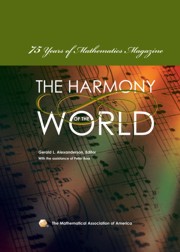Book contents
- Frontmatter
- Introduction
- Contents
- A Brief History of Mathematics Magazine
- Part I The First Fifteen Years
- Part II The 1940s
- Part III The 1950s
- Part IV The 1960s
- Part V The 1970s
- Part VI The 1980s
- Leonhard Euler, 1707–1783
- Love Affairs and Differential Equations
- The Evolution of Group Theory
- Design of an Oscillating Sprinkler
- The Centrality of Mathematics in the History of Western Thought
- Geometry Strikes Again
- Why Your Classes Are Larger than “Average”
- The New Polynomial Invariants of Knots and Links
- Briefly Noted
- The Problem Section
- Index
- About the Editors
The Evolution of Group Theory
from Part VI - The 1980s
- Frontmatter
- Introduction
- Contents
- A Brief History of Mathematics Magazine
- Part I The First Fifteen Years
- Part II The 1940s
- Part III The 1950s
- Part IV The 1960s
- Part V The 1970s
- Part VI The 1980s
- Leonhard Euler, 1707–1783
- Love Affairs and Differential Equations
- The Evolution of Group Theory
- Design of an Oscillating Sprinkler
- The Centrality of Mathematics in the History of Western Thought
- Geometry Strikes Again
- Why Your Classes Are Larger than “Average”
- The New Polynomial Invariants of Knots and Links
- Briefly Noted
- The Problem Section
- Index
- About the Editors
Summary
Editors' Note: Israel Kleiner received his PhD in ring theory under the direction of J. Lambek at McGill University and has been Professor of Mathematics at York University in Ontario since 1965. He became interested in the history of mathematics and has written a long series of articles for MAA and other journals on historical topics. For the one included here he was awarded the Allendoerfer Award in 1987, and then he went on to win another Allendoerfer Award for “Rigor and proof in mathematics: an historical perspective” in 1992; a Lester R. Ford Award (with N. Movshovitz-Hadar) in 1995 for “The role of paradoxes in the evolution of mathematics,” which appeared in the Monthly; and a Pólya Award in 1990 for “Evolution of the function concept: a brief survey” in the College Mathematics Journal.
This article gives a brief sketch of the evolution of group theory. It derives from a firm conviction that the history of mathematics can be a useful and important integrating component in the teaching of mathematics. This is not the place to elaborate on the role of history in teaching, other than perhaps to give one relevant quotation:
Although the study of the history of mathematics has an intrinsic appeal of its own, its chief raison d'être is surely the illumination of mathematics itself. For example the gradual unfolding of the integral concept from the volume computations of Archimedes to the intuitive integrals of Newton and Leibniz and finally to the definitions of Cauchy, Riemann and Lebesgue — cannot fail to promote a more mature appreciation of modern theories of integration.
— C. H. Edwards [11]- Type
- Chapter
- Information
- Harmony of the World75 Years of Mathematics Magazine, pp. 213 - 228Publisher: Mathematical Association of AmericaPrint publication year: 2007

